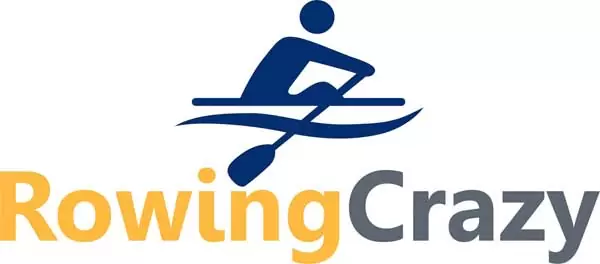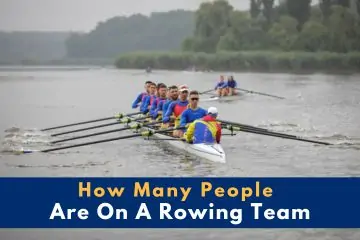
As a passionate rowing enthusiast, I am often asked about the optimal crew size for a rowing team.
It’s a question that many newcomers and even seasoned rowers have, and the answer can vary depending on various factors.
Hi there, I’m Petra, and in today’s article, I want to delve into the world of rowing and explore the dynamics of team size.
Whether you’re a coach looking to build a competitive crew or a rower seeking to understand how many teammates you need to maximize performance, this comprehensive guide will provide you with valuable insights.
I hope you will join me on this journey to unravel the secrets behind the perfect rowing team size for success on the water. Let’s set sail on the path to rowing excellence!
How Many People Are on a Rowing Team?
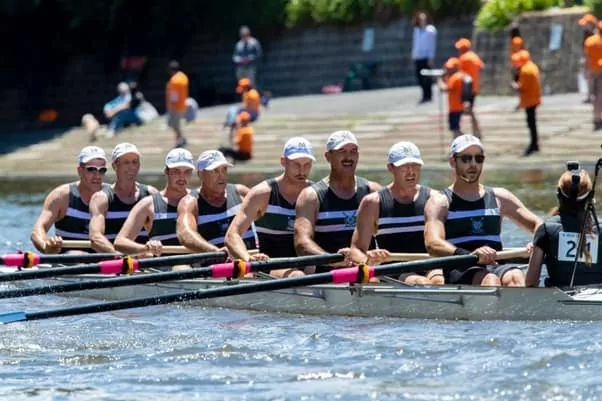
The number of people on a rowing team can vary from 1, 2, 3, 4, 5, and 9, depending on the boat category and the specific event or competition in question.
As I’ve mentioned in related articles, there are two types of rowing- sculling and sweep rowing. Each type has several boat classes, and each class varies in terms of team size.
Generally, rowing teams are in even numbers, except in the case of single sculling or when the boat is accompanied by a coxswain (or cox) who is responsible for steering and coordinating the crew.
Let’s see how the number of people on a rowing team varies between sweep rowing and sculling boat categories.
Sculling Boats
Let’s talk about sculling first, which has several boat classes:
| Sculling Boat Category |
No. of Rowers |
| Single scull | One rower |
| Doubles | Two rowers |
| Coxless Quad | Four rowers |
| Coxed Quad | Four rowers and one coxswain |
| Octuple | Eight rowers and is always coxed |
In rare events, there’s the Octuple, which seats eight rowers and is always coxed – so nine people in a team.
Please take note that in sculling, each rower has two oars. In the smallest boat category (singles), you row solo, so it’s practically a one-man team.
Sweep Boats
In sweep rowing, each rower has only one oar. There has to be an even number of rowers (and oars) for the boat to be balanced, so unlike sculling, there is no single-rower category in sweep rowing.
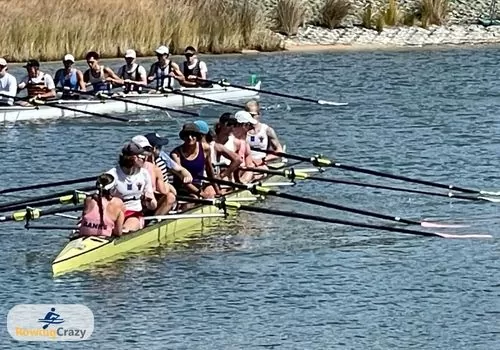
The smallest size of a sweep rowing team is two rowers. Here are the different sweep boat classes and their respective team size:
| Sculling Boat Category |
No. of Rowers |
| Coxless Pair | Two rowers |
| Coxed Pair | Two rowers and one coxswain |
| Coxless Four | Four rowers |
| Coxed Four | Four rowers and one coxswain |
| Eight | Eight rowers and always with one coxswain |
Rowers in seats 1 and 2 of an Eight racing shell are called the bow pair, while those in seats 7 and 8 are the stern pair, each athlete holding specific responsibilities that are critical to their race.
Ultimately, the specific number of people on a rowing team is determined by the type of race and the boat category, making rowing a versatile sport that accommodates a range of team sizes.
How Many People Are on an Olympic Rowing Team?
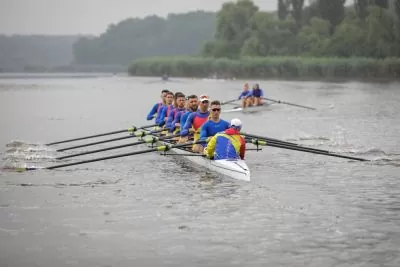
The number of people on an Olympic rowing team can vary from 2, 4, and 9, for the coxless Pairs, coxless Doubles, coxless Fours, and the coxed Eights, including lightweight rowing categories.
An Olympic rowing team consists of a set number of rowers and boats that can compete in various categories, each with a different crew size.
The most common boat category in Olympic rowing and World Championships is the Eight, known as the Men’s and Women’s Eight, consisting of eight rowers and a coxswain, for a total of nine team members.
Additionally, there are the Men’s and Women’s Coxless Pairs (two rowers), Coxless Fours (four rowers), and Double Sculls (two rowers), which are also featured in the Olympic program.
Finally, the lightweight men and lightweight women double sculls include two rowers each. So, the exact number of people on an Olympic rowing team depends on the categories they compete in.
Some rowers may compete in multiple categories, while others may focus on a single event. In essence, the composition of an Olympic rowing team is dynamic. Teams field the appropriate rowers for each boat category as they aim for Olympic gold medals and success on the Olympic Games and World Rowing Championships.
How Many People Actually Row on a Rowing Team?
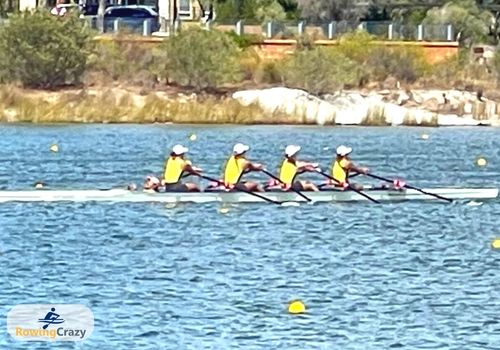
The short answer here is that everyone rows except the coxswain and the coach.
The number of people actively rowing on a rowing team typically ranges from one to eight, depending on the boat category and the type of race.
For example, in a single scull, there is just one rower who operates both oars.
For a double scull, there are two rowers, each with their own set of oars.
The crew size increases to four for a coxless four, and in an eight-oared boat, there are eight rowers, plus a coxswain who steers the boat and coordinates the team but does not row.
The crew size may vary within these categories for different events, making rowing a versatile sport that accommodates different team sizes, from individual scullers to larger teams of rowers.
What Does a Rowing Team Consist of?
My first thought was to say “A rowing team consists of a group of masochists who like the water” but perhaps that wouldn’t be entirely fair, LOL.
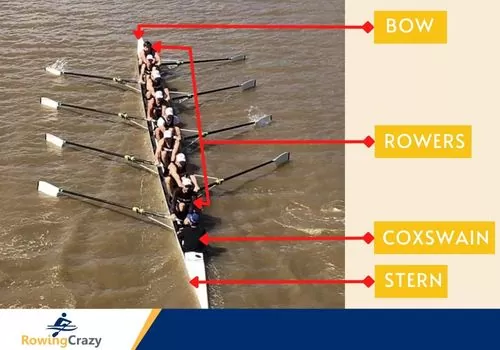
Let me put it this way: a rowing team generally consists of the rowers and a coxswain. It is a group of individuals working collectively to propel a rowing boat efficiently through the water. The team’s composition, and whether it is coxed or coxless, depends on the boat category and the type of rowing event.
For example, in sweep rowing, each rower handles one oar. The most common sweep boat is the coxed eight, which consists of eight rowers (each with one oar) and a coxswain who steers and directs the crew.
Other sweep boat categories include the coxed pair (team of 3), coxless pair (team of 2), coxed four (team of 5), and coxless four (team of 4).
When talking about sculling, each rower manages two oars. Sculling categories include the single scull (one rower), double scull (two rowers), and quadruple scull (four rowers).
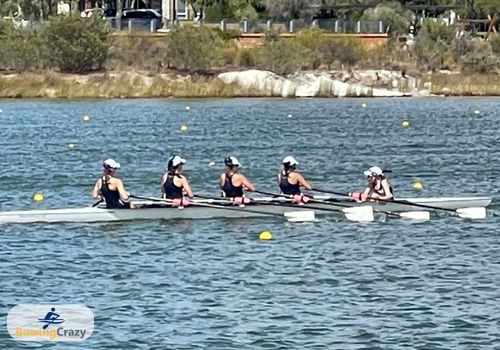
A rowing team is not only about the rowers themselves but also the coxswain who provides guidance, motivation, and race strategy, ensuring the boat moves swiftly and smoothly through the water.
This combination of rowers and coxswain constitutes the core of a rowing team. Their teamwork and synchronized body movements are vital for success in this demanding sport.
That sounds like serious business, doesn’t it? If you want more laughs, check out my article with some rowing humor.
Before You Go
Summing up, the number of individuals on a rowing team varies widely, from a solitary sculler navigating the waters to a nine-person coxed Eight powering through the waves in perfect harmony.
The diversity of boat categories and rowing events within the sport allows for a range of team sizes, accommodating both solo athletes and larger synchronized squads.
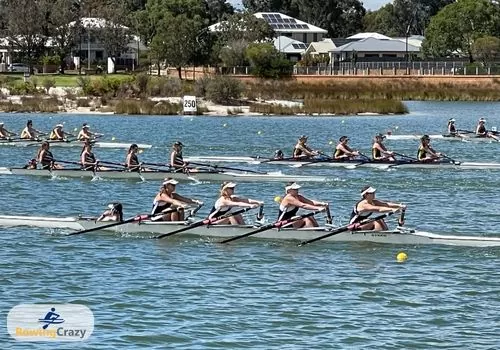
It’s not just about the numbers; it’s also about the teamwork, dedication, and synchronized effort that rowing demands.
Every rower, whether in a small agile boat or a powerful eight-oared vessel, plays a crucial role in the success of the team. The coxswain, too, deserves special recognition for their leadership and guidance.
In the world of rowing, team dynamics, discipline, and a shared passion for the sport come together to create the essence of what a rowing team truly is. They’re a group of individuals bound by their love for the water, pursuit of excellence, and dedication to rowing as one.
Stay positive and happy rowing!
Written by Petra Amara – RowingCrazy.com
CEO & Founder of RowingCrazy, National Rower, Coxswain Womens Eight Team, Rowing Coach & Writer
Petra is a Mother of two and owner of Rowingcrazy.com. Petra lives and breathes rowing, she also has a passion for writing which lead her to start RowingCrazy.com to share her rowing experience and expertise with others.



